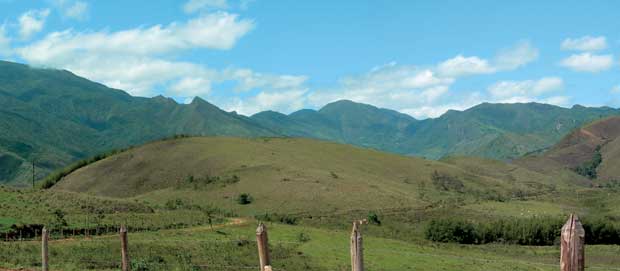
SILVIO HIRUMA / GEOLOGICAL INSTITUTERagged profile on the southeast coastSILVIO HIRUMA / GEOLOGICAL INSTITUTE
A giant channel runs parallel to the coast of Brazil for over 1,000 km from Curitiba, in Paraná , to Barra de São João, in Rio de Janeiro State. It is the Continental Rift of southeastern Brazil, a geological formation that looks like a valley about 100 kilometers wide, through which the Paraíba do Sul River flows. It is flanked by two jagged mountain ranges, the Serra do Mar and the Serra da Mantiqueira, and it is home to cities such as Curitiba, São Paulo, Taubaté, Resende and Volta Redonda. Silvio Hiruma, from the Geological Institute of São Paulo, has been investigating the geology of a stretch of this formation – the Bocaina Plateau – and has concluded that these mountains were formed at very different moments.
The oldest of them came about some 120 million years ago: it was the separation between Africa and America that generated enough stress on the Brazilian coast to also push up the Serra do Mar, which is today to the east of the Paraiba do Sul River. The highest peaks of this range of mountains, at over 2000 meters, comprise the 1800 square kilometers of the Bocaina Plateau, which probably still has parts preserved since before the separation of the continents. “It’s a region that hasn’t suffered from strong erosion and so it’s important to investigate the geological history of this mountain range,” says Hiruma.
The chain further inland is the Serra da Mantiqueira, in which Campos do Jordão is located, a favorite destination for people from São Paulo during the winter, when they enjoy fireplaces, blankets, fondues and hot chocolate, in addition to taking their overcoats out of the closet. This chain was formed around 60 million years later, when geological movements opened up the continental rift.
What allows for the dating of exposure and erosion events in the ancient crystalline rocks that form the region, in which chronological markers are rare, is observing the fission tracks in apatite grains. These are defects in the crystalline structure of the mineral. They are only visible under the microscope after chemical treatment. These tracks are preserved when the rock, heated in deep layers below the earth’s surface, cools down. “The density of these tracks allows us to estimate how long ago that apatite went through more superficial portions of the crust,” explains the geologist. The work is part of the project coordinated by Claudio Riccomini, from the University of São Paulo, one of the pioneers in studying the region and Hiruma’s PhD thesis advisor. Some of the analyses were done at Paulista State University (UNESP), in Rio Claro, in collaboration with Peter Hackspacher’s group.
Dating indicated that the Bocaina Plateau preserves testimonies from very different eras. “It was an accumulation of elevations followed by erosion,” Hiruma explains. The ages indicated by the apatite grains from samples collected at different altitudes of this plateau vary from about 46 million years ago until about 303 million years ago, according to an article published this month in Gondwana Research. In general, the oldest samples are above 1,400 meters, in the region of the headwaters of the Paraitinga River and the Capetinga Stream, and those less than 130 million years old are lower down, such as the region of the Funil River and the Serra da Carioca hills.
If the trend were constant, it would tell a very simple story of mountains rising and being eroded. However, this is not the case: different samples collected at the same altitude showed very different fission track ages from 60 million and 137 million years ago. In addition, a sample 303 million years old was found in the middle of the scarp that is the northern boundary of the Bocaina Plateau, at an altitude of 1,058 meters.
Traces of the past
This age distribution reveals a complex story of diverse geological processes. After separation of the continents, magmatic events in two main pulses, around 80 million and 65million years ago – at the time of the formation of the Continental Rift of southeastern Brazil – also caused the mountains to rise. Over the past few million years, movements of the crust continued to change the geological organization there. All this activity resulted in dramatic changes in the topography, in which river drainage networks are reversed, mountains rise and faults open up like tears.
The comparison with Campos do Jordão, in the Serra da Mantiqueira, is just beginning: there are only 2 samples, versus 27 from Bocaina. For the time being, it seems that the region of Campos do Jordão has rocks that were exposed much later than those of the Bocaina Plateau, which is work that Hiruma and his colleagues intend to continue pursuing in the coming years.
To further complicate the journey in time undertaken by the researchers, the rocks formed and overturned by various processes are not necessarily waiting for geologists to tell their story. Erosive processes that are still happening today already existed hundreds of millions of years ago, so that more superficial testimonies often cease to exist. This makes the job harder and the mosaic more challenging, but not discouraging. The fission track technique has begun being more widely used in geological studies in the last 30 years, which is very recent for this type of research. It opened doors that Hiruma expects will be increasingly explored over the coming decades and will eventually reveal much of the history of this continent.
The project
Morphotectonics and the Cenozoic evolution of the Bocaina Plateau (nº 2003/08031-0); Type Regular Research Awards; Coordinator Claudio Riccomini – IG/USP; Investment R$ 72,035.69
Scientific article
Hiruma, S. T. et al. Denudation history of the Bocaina Plateau, Serra do Mar, southeastern Brazil: Relationships to Gondwana breakup and passive margin development. Gondwana Research. v. 18, n. 4, p. 674-87. Nov. 2010.

